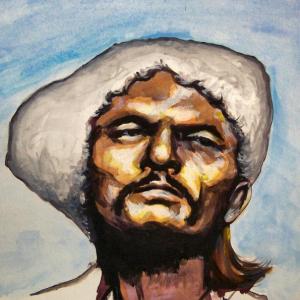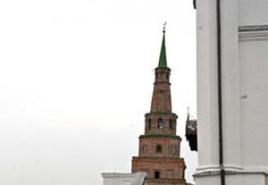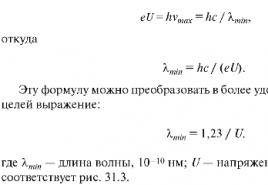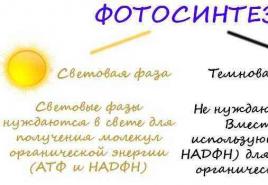Sounds for electronic decoys. About gray and white-fronted geese, about bean goose and geese Calling cry of the white-fronted goose
Electronic decoys hunting season electronic decoys, both Russian and foreign manufacturers.
Electronic decoys or sound simulators are a very popular product among hunters, especially before the start of spring hunting season. Various manufacturers are represented on the Russian market electronic decoys, both Russian and foreign manufacturers.
Electronic decoys They are divided into cassette (already outdated models), on electronic chips, and electronic decoys with digital media. The main indicator of an electronic decoy is the sound quality, as well as the quality of recording animal voices. Most manufacturers record the voices of Russian animals.
IN The design of the decoys is based on modern circuit solutions and proprietary software, which enable the user, if necessary, to independently supplement and change the originally recorded sound image.
All recordings in the electronic sound simulator are of high quality and are the real voices of birds and animals.
The effectiveness of luring birds and animals using electronic sound simulators " Huntsman“is ensured through professional processing of real sounds of nature based on many years of practice of the company’s specialists in selecting really alluring sounds.
The audio file converter allows you to prepare an arbitrary audio file in the format for recording into an electronic sound simulator. WAV while simultaneously reducing extraneous noise.
In order to increase the efficiency of the electronic sound simulators of the "Eger" family, the company has currently developed external passive and active speakers that provide a sound propagation range in windless weather of over 2 km and 4 km, respectively.
Many thanks to our friend QsQsQ who provided his large collection of sounds for electronic decoys
You can download it for review using the links below.
hunting-sound
Snipe
Golden eagle
Woodcock
Bittern
Capercaillie
Gogol
Pigeon
Goose
Thrush
Lark
Kingfisher
Kamyshovka
Keklik
Horse
Landrail
Curlew
Mallard
Partridge
Swamp chicken
Coot
Dive
Eagle
Warbler
Quail
Crake
Great spotted eagle
Grouse
Waxwing
Wigeon
Drake
Tit
Black-headed Warbler
Owl
Common nightingale
SwiftHouse Owl
Grouse
Duck
Owl
gray heron
Crested duck
Teal
Hawk
" Decoy Golden Eagle "
Capercaillie
White-fronted goose
Barnacle Goose
Bean goose
Canada goose
Red-breasted Goose
Lesser Lesser Goose
Gray-footed goose
Gray goose
Dry goose
Brent goose
For the crows
Thrush
Landrail
Quail
Grouse
Gray partridge
Grouse
Red duck (Ogar)
mallard duck
Duck dive
Shelduck duck
Wigeon duck
Gray duck
Duck scoter
Tufted duck
Duck teal whistler
Duck teal wadder
Pintail duck
Shoveler duck
Pheasant
Pigeon (a species of bird of the pigeon genus).mp3
Goose Bazaar.mp3
White-fronted goose 1.mp3
White-fronted goose 2.mp3
White-fronted goose 3.mp3
White-fronted goose - market on the water.mp3
Bean Goose 1.mp3
Bean Goose 2.mp3
Bean Goose 3.mp3
Goose goose - bazaar.mp3
Red-breasted goose.mp3
Black goose.mp3
Lesser goose Lesser white-fronted goose 1.mp3
Lesser goose Lesser white-fronted goose 2.mp3
Gray Goose 1.mp3
Gray Goose 2.mp3
Gray Goose 3.mp3
Coot (small waterfowl of the rail family).mp3
Mallard Duck.mp3
Pochard duck.mp3
Wigeon Duck.mp3
Tufted duck.mp3
Duck teal whistle.mp3
Duck teal codling.mp3
Pintail Duck.mp3
Well, the highlight of the “Decoy Huntsman” collection. When unpacking the archive we get over 700Mb of voices of birds and animals...
Download "Monok Huntsman":
Download "Western Rivers Apache Pro Combo Electronic Call":
Download "N"abor Ornithologist":
We know that geese are sociable birds and hunters who are passionate about this hunt need to know and understand their calls. If you hunt with wind decoys, then this is not difficult to learn. With experience, you can easily determine from the birds' voices and behavior their intentions in relation to your arrangement.
For example, a small flock flies above your hide at an altitude of 25-30 meters, the birds actively communicate with each other, respond to decoys, and there is every chance of lowering the flock even lower. The flock did not break up, but flew in one herd, and this is a sign of alertness. On the next circle, the geese flew away - an experienced hunter would have found his bearings in time and managed to get the geese, because the distance allowed him to make a successful shot.
Let's consider another situation, from approximately one point the geese begin to turn around and fly away from your hiding places, making sounds of danger. For an experienced hunter, this is a hint that something is wrong, for example, in camouflage or something else, and you need to look for an error. Or such a situation, a flock of geese flying at a decent altitude, 300 meters, began to respond to your decoys, the geese circled over the stuffed animals, began to break into many small herds and fly over the stuffed animals several stories high (as hunters say).
At the same time, the geese are actively vocalizing; take your time, these geese have intentions of joining your stuffed animals. If possible, try to lower the geese as low as you can be patient. It’s an indescribable feeling when geese fly 5 meters above you, and some are already sitting in stuffed animals. You hear the flapping of wings, the cracking of feathers - this is a completely different stage of hunting than shooting geese at a distance of 30-40 meters. Now let’s listen to the sound files and try to make out the voices of the geese:
3. The sound of danger. In our case, the geese noticed the video camera; if these sounds are repeated regularly, look for a mistake. As a rule, this is a disguise or poor quality of profiles or stuffed animals.
5. A flock of white-fronted geese. When the geese make such noise and begin to break down, you can plant them, they are happy with everything.
6. This is a continuation of file 5. Geese are already flying at an altitude of 10-15 meters, and there is a further decline. An indescribable feeling.
7. Roll call of a small flock of white-fronted geese. Have fun and lure them in point blank.
8. A mixed flock of white-fronted and bean geese. Only 6 pieces separated from the flock, the rest in one herd - the first sign of doubt. When flying at 15-20 meters, shoot, there are doubtful geese in the flock.
Version 5, updated in 2014
Folder No. 1. "Geese"(calling cries, bazaars, cries of a feeding flock, sieges)
01. White-fronted goose; market of a large resting flock, about 100 individuals.
02. White-fronted goose, male; active call.
03. White-fronted goose; market of a resting and feeding flock (20-30 individuals).
04. White-fronted goose; market of a resting and feeding flock (10-15 individuals).
05. White-fronted goose, feeding male; call.
06. White-fronted goose, male; siege (invitation to board).
07. White-fronted goose; feeding geese, flock of 8-10 individuals.
08. White-fronted goose, female; call.
09. White-fronted goose; resting geese, a flock of 8-10 individuals, the calls of females and males are clearly audible.
10. White-fronted goose, female; siege (invitation to board).
11. White-fronted goose; market of a small feeding and resting flock.
12. White-fronted goose; roll call of the couple.
13. White-fronted goose; market of feeding and resting flocks.
14. White-fronted goose, male; call.
15. White-fronted goose; bazaar of the resting flock.
16. white-fronted goose; market of feeding and resting flocks.
17. White-fronted goose; mating cries of the couple.
18. Mixed market (white-fronted + bean goose); resting and feeding flocks.
19. Bean goose: call of the female.
20. Bean goose, female; siege (invitation to board).
21. Bean goose, male; active call.
22. Bean goose; roll call of a small flock.
23. Bean goose; market of feeding and resting flocks.
24. Bean goose, male; call.
25. Gray goose; market of feeding and resting flocks on the ground.
26. Gray goose, female; call.
27. Gray goose, female; siege.
28. Gray goose; market of feeding and resting flocks.
29. Gray goose, male; call.
30. Gray goose, male; siege.
31. Gray goose; market of feeding and resting flocks.
32. Gray goose; market of feeding and resting flocks.
33. Gray goose; calling cry.
34. Gray goose; market of feeding and resting flocks.
35. Gray goose; roll call of the couple.
36. Gray goose; roll call of the couple.
37. Gray goose; roll call of a pair with a brood.
38. Gray goose, male; courtship.
39. Barnacle goose; bazaar
40. Barnacle goose; bazaar
41. Barnacle goose; bazaar
42. Barnacle goose; bazaar
43. Barnacle goose; single cry.
44. Barnacle goose; single cry.
45. Barnacle goose; roll call of a small flock.
Folder No. 2. "Ducks"(calls, basic species calls)
01. Call + precipitation; the most common combination in nature and characteristic of the mating season is the combination of typical voices of a female mallard (recording from a high-quality decoy duck).
02. Mallard, female; call (recording from a high-breed decoy duck).
03. Mallard, female; sediment (invitation to mating), (recording from a high-breed decoy duck).
04. Call + precipitation; the most common combination of typical voices of a female mallard in nature and characteristic of the mating season.
05. Mallard, female; standard call.
06. Mallard, female; standard draft (invitation to mating).
07. Mallard, drake; call.
08. Mallard; spring roll call of the couple.
09. Mallard, autumn market of a small flock of ducks on the water (4-5 drakes, 8-9 females).
10. Wigeon, female.
11. Wigeon, male.
12. Wigeon, roll call of a pair.
13. Pintail, pair roll call; spring.
14. Pintail, roll call of several individuals; weight.
15. Pintail, female.
16. Shoveler, male.
17. Teal, female; call.
18. Teal-whistle, male.
19. Teal; roll call of the couple.
20. Teal, male.
21. Spring market of teal and whistling teal.
22. Red-headed Pochard, female.
23. Red-headed pochard, male.
24. Red-headed duck, roll call of several individuals; spring.
25. Gogol, female.
26. Sea duck, female.
27. Tufted duck, female.
28. Tufted Duck; couple roll call
29. Turpan, female.
30. Turpan, female.
31. Humpbacked scoter, female.
32. Singa, female.
33. Ogar; roll call of female and male.
34. Ogar, female.
35. Ogar; market of a small flock.
Folder No. 3. Duck bases" (duck markets)
01. Mallard + teal; bazaar
02. Mallard + teal + teal; bazaar
03. Mallard + pintail; bazaar
04. Mallard; bazaar
05. Teal-whistle; bazaar
06. Whistling teal + cracking teal; bazaar
07. Whistling teal + cracking teal; bazaar
08. Pintail; bazaar
09. Pintail + teal; bazaar
10. Pintail + teal + whistling teal.
11. Pintail; bazaar
12. Wigeon; bazaar
13. Wigeon + Tufted Duck; bazaar
14. Wigeon+pintail; bazaar
15. Red-headed Pochard; bazaar
01. Mallard, female; brood calling (short).
02. Mallard, female; brood calling (extended).
03. Market of actively feeding mallards on the water.
04. Bazaar of feeding and resting mallards.
Currently, sport goose hunting is a hobby for millions of people in many countries around the world. A civilized hunter must know the rules of hunting in his region and be able to distinguish protected species of geese from those that are allowed to be hunted.
Gray geese, white-fronted geese and bean geese are members of the genus Anser of the Anatidae family of the Anseriformes order.
GOOSE GRAY |
|
Features. Large goose. The body length reaches up to 90 cm, the wingspan is up to 1.5 - 1.7 meters. The weight of adult males in autumn reaches 3.5 – 5 kg. Females are slightly smaller. The color of the plumage is light gray tones. Mature birds have a crop and abdomen with small black transverse streaks. The beak is a solid pink color with a white claw at the end. Paws are red-pink. The eyes are light brown. The voice is sharp, cackling, reminiscent of the sounds made by domestic geese. The flight of gray geese is fast; during long flights they fly high, often lining up in a wedge. They usually do not mix with other species of geese.
Habitat. Mainly lives in the southern half of Russia. It nests especially willingly on large lakes with reed fields, in river deltas, in floodplains and estuaries. The main population is concentrated in the Volga delta, Kazakhstan, and Western Siberia. In the European part it nests unevenly. Prefers biotopes of forest-steppe and steppe zones. Winters in Azerbaijan, southern Ukraine, the republics of Central Asia, as well as in the countries of Western Europe, South and Southeast Asia.
The number has stabilized in recent years and, according to some sources, reaches up to 150 thousand individuals.
WHITE-FRONTED GOOSE |
 |
|
Features. The most numerous species of our geese. Body length 60 – 90 cm, wingspan up to 1.5 meters. The weight of adult males in autumn reaches 2.5 - 3 kg. The color of the plumage of an adult bird is mainly gray, lighter below, the undertail is white. There is a white spot on the forehead surrounded by a dark border. Mature birds have large transverse black streaks on their bellies. The beak is 40–55 mm long, pinkish, with a white claw at the end, the legs are orange. Young birds do not have a white spot on the forehead and there are no dark streaks on the belly. Unlike other species of geese, the white-fronted goose has a tail that protrudes from under the ends of its folded wings. The male's voice is high, sharp, shrill, two or three syllables; in the female, low-frequency components predominate.
|
Gander call |
Your browser does not support this player. UPDATE YOUR BROWSER! |
|
Active gander call |
Your browser does not support this player. UPDATE YOUR BROWSER! |
|
Calling the goose |
Your browser does not support this player. UPDATE YOUR BROWSER! |
|
Siege of the Goose |
Your browser does not support this player. UPDATE YOUR BROWSER! |
|
Bazaar of a small flock |
Your browser does not support this player. UPDATE YOUR BROWSER! |
|
Bazaar of the Resting Pack |
Your browser does not support this player. UPDATE YOUR BROWSER! |
|
Flying Flock Bazaar |
Your browser does not support this player. UPDATE YOUR BROWSER! |
TUNDRA (WESTERN AND EASTERN) SUBSPECT (Anser Frossicus)
|
|
Features. The most numerous subspecies of bean goosebumps. Body length 70 – 75 cm, wingspan up to 1.5 meters. The weight of a goose of this subspecies reaches 3–4 kg. The color of the plumage is dominated by brown-gray tones. The upper part of the small head and neck is dark brown. The crop and belly are light gray. The rim of the feathers is white. The beak is relatively short, swollen, usually no more than 70 mm. The mandible has a pronounced thickening in the center. The base and claw are black, the band is noticeably narrow, yellow-red in color. Paws are yellow-orange. The voice is harsh, cackling, creaking, mainly with a predominance of low and mid tones. Habitat. Tundra bean goose nests are widespread in continental tundra and forest-tundra swamps. This subspecies is also found on some Arctic islands. They winter in Western Europe, the Mediterranean, South and Southeast Asia. |
FOREST SUBSPECT (Anser Fabalis)
|
|
Features. A large, densely built bird. Body length 70 – 90 cm, wingspan 1.5 – 1.7 meters. Weight from 3 to 4.5 kg. The head and neck are brown with a slight buffy tint. The front of the back and wing coverts are grayish-brown, the middle of the back, loin and flight feathers are black-brown. The crop and chest are whitish-gray. The belly and undertail are white. The sides are dark with light transverse stripes, the beak is large and two-colored: black with a wide orange band ending in a black claw, the legs are red-orange. The voice is sharp, mainly a low-frequency two-three complex nasal guttural cackle. Habitat. Inhabits forest and forest-tundra biotopes in Western Siberia. It nests spontaneously, in pairs or small family groups in interfluves and along the edges of remote lakes. Does not form colonies. A very careful bird. Winters in Western Europe, the Mediterranean, countries of South and Southeast Asia. |
TAIGA SUBSPECT (Anser Fabalis Latham)
|
|
Features. Large bird. Body length 70 – 90 cm, wingspan 1.5 – 1.7 meters. Weight 3.5 – 4.5 kg. The color of the plumage is mainly gray-brown, the crop and chest are gray, and the undertail is white. On the sides of an adult goose, light transverse stripes are clearly visible, which young birds do not have. The head and neck are noticeably darker than the main background. The beak is large black with an orange-red band and a dark claw. Paws are bright orange. Voice in flight ─ low-frequency, two-syllable, repeating cackling sounds. An extremely cautious bird. Habitat. The number of taiga bean geese within the areola is distributed extremely unevenly. Estimates of the status of this subspecies vary, according to various sources, from 15,000 to 60,000 individuals and reflect the general trend of declining numbers. Inhabits forest and forest-tundra biotopes of Eastern Siberia. Winters in Western Europe, the Mediterranean, countries of South and Southeast Asia. |
SHORT-BILLED SUBSPECT (Anser Brachyrhynchus)
|
|
Features. The smallest among bean goosebumps. Body length 65 – 68 cm, wingspan up to 1.3 meters. Weight about 3 kg. The plumage is generally dark, black-brown on the upper side of the head, rusty-brown on the neck, the upper back is matte black, the undertail is white, the chest and belly are gray, the beak is short, thick, dark with a pink-red band. The wings are short and, when folded, do not reach the end of the tail, the front part of which is noticeably lighter. A voice with short, sharp, cackling sounds of low and medium tonality characteristic of bean goosefish. Habitat. Island subspecies of bean goose. Some ornithologists consider it a separate species, which emerged as a result of geographic isolation from mainland bean beans. Its nesting areas are located in the inland swamps of Iceland, Spitsbergen, and East Greenland. In Russia it is found in the north-west of the country. A case of shooting a ringed bird on Lake Ilmen was recorded. Breeds on the Yugorsky Peninsula and Kolguev Island in small numbers. Winters in England, the Netherlands, and Greenland. |
Barn Goose |
|
Branta Leucopsis
|
|
Features. A small goose of the genus Goose of the Anatidae family. Body length 60 - 70 cm, wing length 38 - 43 cm, weight 1 - 2.5 kg. It has two-color plumage. Black on top, white on bottom. There are gray stripes on the sides of the body. The black “cap” on the head extends to the neck, crop and forms a sharp border with the light chest. The cheeks are white except for a black frenulum running from the base of the beak to the eyes. The male and female are indistinguishable in color. The voice is sharp and shrill. Resembles a hoarse bark or cough. The flight is fast. Birds often change formation, break formation, and fly in a dense flock.
Habitat. They winter on the shores of the northern seas, in Holland, Germany, and Denmark. Spring migration occurs in a rather narrow front along the coasts of the North and Baltic seas. Breeds in large numbers on Novaya Zemlya and Vaygach Island. In recent decades, open tundra and coastal meadows on the coast of the Barents Sea have been developed.
In 1997, it was removed from the Red Book of Russia. Currently, the population has increased to half a million and continues to grow rapidly (E.N. Gurtovaya). The first reason for the rise was the protection of wintering grounds and the restoration of feeding grounds along the flight routes. The late timing of migration of barnacle geese is of considerable importance. Thanks to this, the bulk of birds fly after the close of the spring hunting season (V.B. Zimin). During the autumn migration, according to individual tagging data (Afanasiev 2005), from nesting sites from the mouth of the Pechora River to wintering grounds in Western Europe (about 3000 km), they make no more than two or three short-term stops and reach the goal in 1 - 3 days .
Characteristics of wintering sites of the white-fronted goose in Europe and Western Asia
|
A country |
Number |
Average |
Lim and average geographic coordinates |
|
|
I. Northern European wintering grounds of the white-fronted goose |
||||
|
England |
1 |
0,35-4,9 |
51.35 N |
2.45 W |
|
II. Central European wintering grounds of the white-fronted goose |
||||
|
Hungary |
16 |
0,32-7,62 |
46.15-47.37 N |
17.09-21.36 E |
|
III. Southern European wintering grounds of the white-fronted goose |
||||
|
Bulgaria |
6,2-111,2 |
42.04-44.02 N |
24.30-28.32 E |
|
|
IV. European-Fore Asian wintering grounds of the white-fronted goose |
||||
|
Türkiye |
7 |
0,7-10,33 |
38.12-39.32 N |
29.56-35.14 E |
Key ornithological territories of the European part of Russia,
in which the white-fronted goose is a significant spring migrant
Olonets spring flocks of birds. Geese
V.B. Zimin, A.V. Artemyev, N.V. Lapshin, A.R. Tyulin. 2007, Nauka publishing house
|
Name of area |
Geographical |
Number |
|
Nenets Autonomous Okrug |
66°49" N 46°30" E |
Mass stops |
|
Komi Republic |
62°16" N 50°36" E |
500 - 1 000 |
|
Arhangelsk region |
61°50" N 38°55" E |
Mass stops |
|
Republic of Karelia |
60°56" N 32°55" E |
500 000 - 7 500 000 |
|
Kaliningrad region |
54°56" N 21°14" E |
Mass stops |
|
Leningrad region |
60°00" N 29°15" E |
3 000 |
|
Pskov region |
58°30" N 27°40" E |
Numerous |
|
Novgorod region |
58°10" N 31°20" E |
Listed in publications |
|
Vologda Region |
59°20" N 38°30" E |
20 000 - 50 000 |
|
Yaroslavl region |
57°43" N 39°13" E |
3 000 |
|
Ivanovo region |
56°30" N 41°45" E |
Up to 20,000 at the beginning of the flight |
|
Tver region |
57°00" N 36°30" E |
1 000 - 2 000 |
|
Moscow region |
56°42" N 38°02" E |
7 000 |
|
Ryazan Oblast |
55°35" N 40°00" E |
10 000 - 12 000 |
|
Kaluga region |
54°10" N 35°55" E |
6 000 - 15 000 |
|
Bryansk region |
52°30" N 33°37" E |
20 000 |
|
Tambov Region |
52°44" N 40°20" E |
4 000 - 5 000 |
|
Rostov region |
48°00" N 42°40" E |
Stops |
|
Krasnodar region |
46°30" N 38°25" E |
Stops |
|
Stavropol region |
45°13" N 42°51" E |
Stops |
|
The Republic of Dagestan |
41°52" N 48°30" E |
Common |
|
The Republic of Mordovia |
54°23" N 43°50" E |
5 000 - 15 000 |
|
Republic of Tatarstan |
56°05" N 49°50" E |
1 500 - 2 000 |
|
Saratov region |
50°18" N 48°40" E |
Stops |
|
Volgograd region |
50°18" N 46°25" E |
|
|
Republic of Kalmykia |
46°11" N 43°00" E |
|
|
Orenburg region |
50°59" N 61°35" E |
Common |
ACOUSTIC ALARM OF WHITE-FRONTED GOOSE ANSER ALBIFRONS
(Dissertation of candidate of biological sciences Evgeniy Arsenevich Krechmar, St. Petersburg, 2008)
general characteristics
In birds, acoustic signaling occupies a special place among all forms of communicative behavior. The ability to fly requires both a “mobile” and distant (at a distance) effective communication channel. Birds are characterized by a high level of diversity of sound responses, which is reflected both in the richness of forms and in the flexibility of their use in task conditions that change throughout the annual cycle. Birds with the maturonate type of breeding, which include Anseriformes, are characterized by differentiation in the use of acoustic communication when communicating in different social groups at different stages of the breeding season.
The formation of the acoustic repertoire of the white-fronted goose is divided into two main stages. At the first stage, the formation and development of the youthful (juvenile) repertoire takes place, and at the second stage, the adult (definitive) repertoire occurs.
In the repertoire of females there are signals comparable in characteristics of filling the frequency range with males; the main part of their acoustic repertoire has a more pronounced low-frequency content. Males, on the other hand, have a narrower range of frequencies that constitute the energy spectral maximum in the signals of the repertoire.
The frequency range used by males completely overlaps the frequency range used in acoustic signaling by females. The voice of female white-fronted geese has a wider frequency range than that of males. At the same time, a significant part of the signals in the females’ repertoire is characterized by a predominance of well-defined low-frequency components.
The white-fronted goose is a species in which multifunctionality of acoustic signals in its repertoire is the norm. An exception is the two-beat call of the male AM11, used to warn of the danger of chicks at short distances. Four signals (A2; AM9; AF10; AF14) had a high level of multifunctionality. In addition to flight, they were used in foraging behavior and various types of terrestrial-aquatic locomotion. The ground contact-orienting “silent” signal of male AM7 accompanied the largest number (6) forms of motor activity. Signals AM7 and AF13, by their specificity, were ground-contact. They were used in close interactions in dense groups, especially in broods and brood groups. These signals accompany “calm” forms of behavioral activity that are not directly related to the complex of anxious and defensive actions.
Throughout the life cycle of the white-fronted goose, the stages of development of acoustic signaling are consistent with the stages of ontogenesis. The role of acoustic signaling changes at different stages of the life cycle. The entire sequence of changes in age repertoires corresponds to the information needs of various life cycles. At different stages of the life cycle, the conditions and tasks of the existence of geese change. However, there is no direct correlation between the number of tasks corresponding to developmental stages and the diversity of the current repertoire. First of all, this is explained by the phenomenon of probabilistic specificity of the signal repertoire, in which the multifunctionality of individual signals manifests itself with different levels of probability in different situational contexts.
When solving biological and specific current behavioral problems, the information load is determined by the need for the amount of information necessary and sufficient for the proper implementation of the required forms of behavior. Requirements for the level of reliability of information transfer also vary from task to task. In some cases (such as a state of extreme danger that threatens the life of an individual or brood), the requirements for reliability are very high; in other cases (foraging, orientation-demonstrative behavior, for example), the reliability of the communication channel may be low. The acoustic communication channel provides a high level of reliability. A number of physical prerequisites characteristic of acoustic signaling determine the effectiveness of the acoustic communication channel in the conditions of the existence of the white-fronted goose at breeding sites.
Considering the list of parameters that are important when considering the requirements for communication channels for the white-fronted goose, we can note the following important characteristics that make the acoustic channel indispensable: circular directivity, range, noise immunity, stealth, efficiency and the possibility of localization. All of the above prerequisites make acoustic signaling in the white-fronted goose the main and most effective channel of communication and orientation.
All other possible channels impose serious restrictions on the possibility of transmitting information in the various conditions characteristic of the habitat of this species. Acoustic signaling in the white-fronted goose is a typical example of an optimized, species-specific communication system, flexibly adapted to a wide range of life tasks and functions at different stages of the life cycle.
White-fronted goose call labels.












